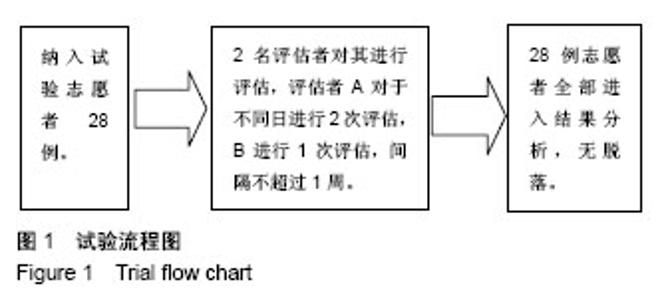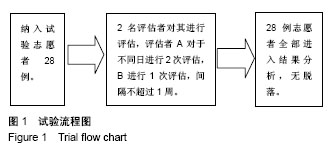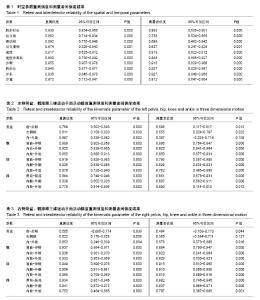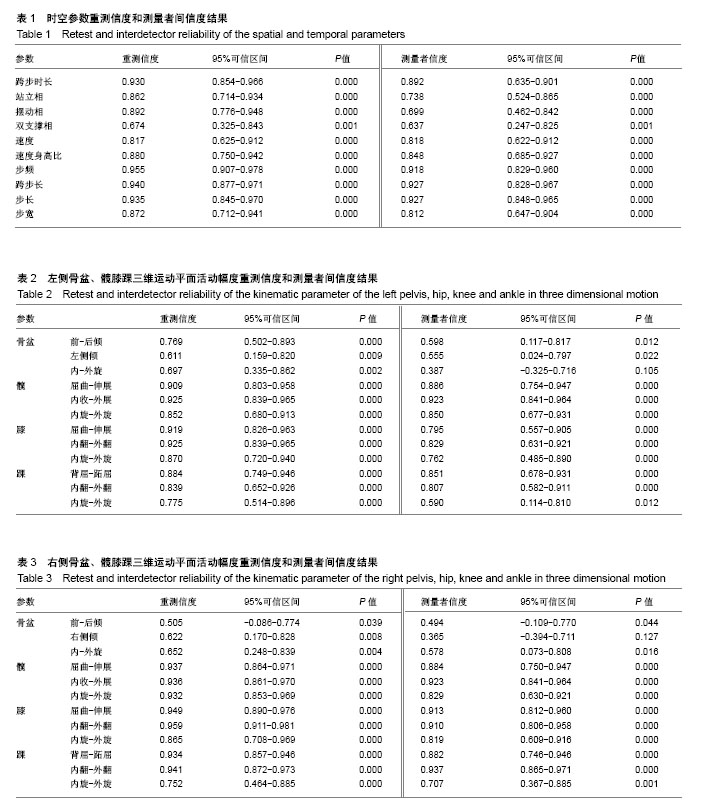| [1] 黄萍,钟慧敏,陈博,等. 正常青年人三维步态:时空及运动学和运动力学参数分析[J]. 中国组织工程研究,2015,19(24):3882-3888.[2] 吴希希,钱竞光,康延琳. 步态分析技术在偏瘫康复中的应用研究[J]. 南京体育学院学报(自然科学版),2016,15(3):37-41+81.[3] 王盛,朱晓军,王彤. 三维运动分析系统在平衡功能检测中的应用[J]. 中国康复医学杂志, 2011,26(4):387-390.[4] 胡雪艳,恽晓平,王广志,等. 基于数字视频和图像处理的步态分析系统信度研究[J]. 中国康复理论与实践,2005,11(8):599-600.[5] 王康玲,黄杰斌,吴文,等. 一种便携式步态分析系统的信度研究[J]. 中国康复医学杂志,2016,31(7):761-764.[6] 王盛,伍琦,朱奕,等. 便携式步态分析与实验室步态分析时空参数的一致性研究[J]. 中华物理医学与康复杂志,2014,36(8):621-624.[7] 李威,曾祥斌,章荣,等. 核心稳定性训练对脑卒中偏瘫患者步态时空参数和对称性参数的影响[J]. 中国康复医学杂志,2014,29(9):816-822.[8] Murodelaherran A, Garciazapirain B, Mendezzorrilla A. Gait analysis methods: an overview of wearable and non-wearable systems, highlighting clinical applications. Sensors. 2014;14(2):3362.[9] Nardo A, Anasetti F, Servello D, et al. Quantitative gait analysis in patients with Parkinson treated with deep brain stimulation: the effects of a robotic gait training. Neurorehabilitation. 2014;35(4):779.[10] Spaulding SJ, Barber B, Colby M, et al. Cueing and gait improvement among people with Parkinson's disease: a meta-analysis. Arc Phys Med Rehabil. 2013;94(3):562.[11] Zhou M, Zhang W, Chang J, et al. Gait analysis in three different 6-hydroxydopamine rat models of Parkinson's disease. Neurosci Lett. 2015;584:184-189.[12] Hatanaka N, Sato K, Hishikawa N, et al. Comparative gait analysis in progressive supranuclear palsy and Parkinson's disease. Eur Neurol. 2016;75(5-6):282.[13] Galey SA,Lerner ZF,Bulea TC,et al. Effectiveness of surgical and non-surgical management of crouch gait in cerebral palsy: A systematic review. Gait Post. 2017;54:93-105.[14] Novacheck TF. Gait patterns for children with cerebral palsy: proceed with caution. Dev Med Child Neurol. 2017;59(1):12-13.[15] Bickley C, Linton J, Scarborough N, et al. Correlation of technical surgical goals to the GDI and investigation of post-operative GDI change in children with cerebral palsy. Gait Posture. 2017;55:121.[16] Aiona M, Do KP, Feng J, et al. Comparison of rectus femoris transfer surgery done concomitant with hamstring lengthening or delayed in patients with cerebral palsy. J Pediatric Orthop. 2017; 37(2):107.[17] Roberts A, Stewart C, Freeman R. Gait analysis to guide a selective dorsal rhizotomy program. Gait Posture. 2015;42(1):16-22.[18] Davies RJ, Parker J, Mccullagh P, et al. A personalized self-management rehabilitation system for stroke survivors: a quantitative gait analysis using a smart insole. Jmir Rehabil Assist Technol. 2016;3(2):e11.[19] Kesikburun S. Effect of ankle foot orthosis on gait parameters and functional ambulation in stroke. FTR. 2016.[20] Parafita F, Ferreira P, Raab D, et al. Evaluating Balance, Stability and Gait Symmetry of Stroke Patients using Instrumented Gait Analysis Techniques[C]// Joint International Conference on Multibody System Dynamics, 2016.[21] Yoshikawa K, Mizukami M, Kawamoto H, et al. Gait training with Hybrid Assistive Limb enhances the gait functions in subacute stroke patients: A pilot study. Neurorehabilitation. 2017;40(1):87.[22] Stevens J, Meijer K, Bijnens W, et al. Gait Analysis of Foot compensation after arthrodesis of the first metatarsophalangeal joint. Foot Ankle Int. 2016;38(2):181-191.[23] Wang H, Foster J, Franksen N, et al. Gait analysis of patients with an off-the-shelf total knee replacement versus customized bi-compartmental knee replacement. Int Orthop. 2017. doi: 10.1007/s00264-017-3622-z.[24] Colgan G, Walsh M, Bennett D, et al. Gait analysis and hip extensor function early post total hip replacement. J Orthop. 2016;13(3):171-176.[25] Belvedere C, Cadossi M, Tamarri S, et al. Impingement and range of motion in total hip replacement: A three-dimensional gait and video-fluoroscopic analysis. Gait Posture. 2016;49:S19-S19.[26] Jones DA, Moed BR, Karges DE. Does modified footwear improve gait after ankle arthrodesis? J Foot Ankle Surg. 2015;55(1):5-8.[27] Cimolin V, Galli M, Vismara L, et al. Gait analysis in anorexia and bulimia nervosa. J Appl Biomater Funct Mater. 2013;11(2):122-128.[28] Danino B, Erel S, Kfir M, et al. Influence of orthosis on the foot progression angle in children with spastic cerebral palsy. Gait Posture. 2015;42(4):518-522.[29] Hatton AL, John D, Keith R, et al. Altering gait by way of stimulation of the plantar surface of the foot: the immediate effect of wearing textured insoles in older fallers. J Foot Ankle Res. 2012;5(1):1-6.[30] Ceseracciu E, Sawacha Z, Cobelli C. Comparison of markerless and marker-based motion capture technologies through simultaneous data collection during gait: proof of concept. Plos One. 2014;9(3):e87640.[31] Park SW, Park HS, Kim JH, et al. 3D displacement measurement model for health monitoring of structures using a motion capture system. Measurement. 2015;59:352-362.[32] Cescon C, Tettamanti A, Barbero M, et al. Finite helical axis for the analysis of joint kinematics: comparison of an electromagnetic and an optical motion capture system. Arch Physiother. 2015;5(1):8.[33] Benedetti MG, Merlo A, Leardini A. Inter-laboratory consistency of gait analysis measurements. Gait Posture. 2013;38(4):934.[34] ?uk M, Pezowicz C. Kinematic analysis of a six-degrees-of-freedom model based on ISB recommendation: a repeatability analysis and comparison with conventional Gait Model. Appl Bionics Biomech. 2015;2015:1-9.[35] Bruno P, Barden J. Comparison of two alternative technical marker sets for measuring 3D pelvic motion during gait. J Biomech. 2015; 48(14):3876.[36] Harris GF. Foot and ankle motion analysis[M]. CRC Press, 2008: 23.[37] Jenkyn TR, Nicol AC. A multi-segment kinematic model of the foot with a novel definition of forefoot motion for use in clinical gait analysis during walking. J Biomech. 2007;40(14):3271-3278.[38] Louey MGY, Mudge A, Wojciechowski E, et al. A model to calculate the progression of the centre of pressure under the foot during gait analysis. Gait Posture. 2013;38(4):934.[39] Oosterwaal M, Carbes S, Telfer S, et al. The Glasgow-Maastricht foot model, evaluation of a 26 segment kinematic model of the foot. J Foot Ankle Res. 2016;9(1):1-10.[40] Kainz H, Graham D, Edwards J, et al. Reliability of four models for clinical gait analysis. Gait Posture. 2017;54:325. |



